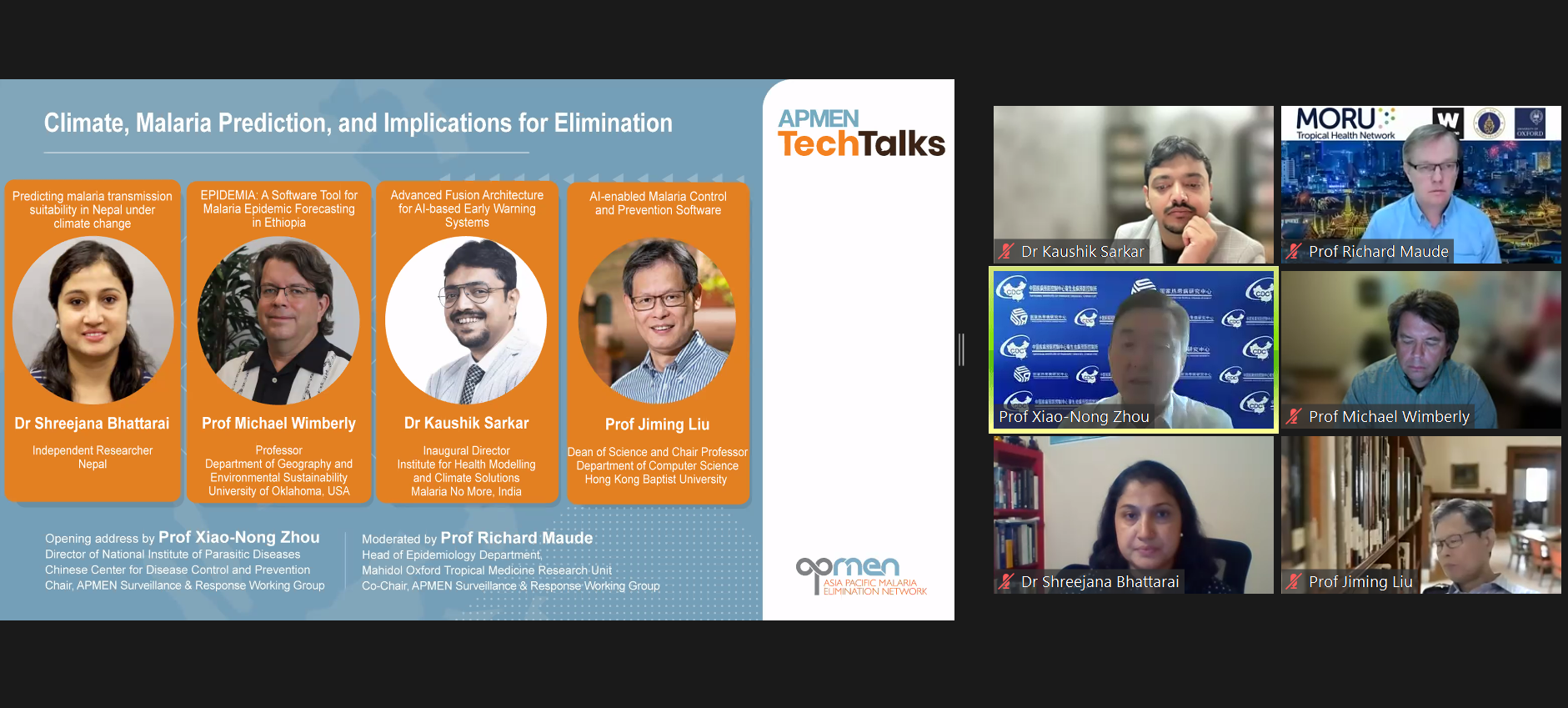
Malaria, a life-threatening disease transmitted through the bite of infected mosquitoes, has troubled humankind for centuries. Efforts to control and eventually eliminate this deadly illness have seen progress in Asia Pacific countries. Still, challenges persist, particularly in regions where climate plays a significant role in malaria transmission. To address these challenges and explore innovative solutions, the APMEN Surveillance and Response Working Group (SRWG) organized a TechTalks webinar on October 2nd titled "Climate, Malaria Prediction, and Implications for Elimination." The event brought together experts and researchers to discuss the critical intersection of climate, malaria prediction, and the eliminating this devastating disease.
The Opening Remarks:
The event commenced with Prof Xiao-Nong Zhou, Director of the National Institute of Parasitic Disease, Chinese CDC, highlighting the crucial relationship between climate and malaria for effective control and elimination. Prof Richard J Maude, Head of MORU Epidemiology and Co-Chair of the SRWG, introduced the topic and moderated the discussions, setting the stage for an insightful and engaging conversation.
Predicting Malaria Transmission Suitability Based on Climate Projections:
Dr. Shreejana Bhattarai, who holds a PhD from the University of Florida, presented her dissertation on predicting malaria transmission suitability in Nepal amid climate change scenarios. She explored into the historical context of malaria in Nepal, its declining cases, and the nation's goal of malaria elimination by 2026. Using temperature-dependent models and climate data, her study predicted an expansion of malaria transmission suitability towards the north, which poses significant challenges to elimination efforts. The results revealed potential mismatches between emerging risk areas and existing vector control interventions, suggesting the need for adjustments in malaria control and elimination strategies.
The EPIDEMIA: A Software Tool for Malaria Epidemic Forecasting:
Professor Michael Wimberly, from the University of Oklahoma, shared insights into a decade-long effort in collaboration with Ethiopian colleagues to develop a malaria forecasting system called EPIDEMIA. This system integrates disease and environmental monitoring for integrated assessment, emphasizing the importance of forecasting in Ethiopia due to historically unpredictable and severe malaria epidemics. Prof. Wimberly outlined the system's conceptual framework, data sources, and the development of cloud-based technology for efficient data processing. He introduced prediction models: early detection and early warning, along with the application of generated alert maps in public health decision-making. His presentation underscored the importance of data science capacity building in Africa and the potential extension of this approach to different diseases and geographic settings.
Advanced Fusion Architecture for AI-Based Early Warning Systems:
Dr. Kaushik Sarkar, representing the Institute for Health Modeling and Climate Solutions, presented an innovative Fusion architecture for malaria early warning systems. His presentation detailed the intricacies of an artificial intelligence-based long and short-term memory model, showcasing its ability to handle nonlinearities and integrate external factors. The fusion architecture significantly enhances prediction accuracy, as demonstrated through benchmarking against various models. Dr. Sarkar also shared insights into the human-centered design approach, front-end interfaces, and the country distribution model of the implemented ecosystem, extending the technology transfer to Indonesia.
AI-Enabled Malaria Control Prevention Software:
Professor Jiming Liu, hailing from Hong Kong Baptist University, outlined an AI-driven malaria control system that integrates diverse technologies for data collection, risk prediction, and detailed risk representation. This system optimally allocates resources, predicts likely cases, and employs mobile apps for local reporting. Professor Liu demonstrated the system's application in the Myanmar-China border region, showcasing its effectiveness in dealing with cross-border human mobility and imported cases. Ongoing deployments in countries like Cambodia, Sri Lanka, and Thailand highlight the promise of this innovative approach.
The APMEN TechTalks webinar was attended by 120 individuals from 34 countries, reflecting the global interest in addressing the challenge of malaria elimination. The discussions and presentations highlighted the importance of understanding the impact of climate on malaria transmission and the need for innovative approaches to prediction and control. To watch the full recording of this insightful event, click here.
In the ongoing battle against malaria, innovative technologies are essential for achieving the ultimate goal of malaria elimination. The TechTalk served as a reminder that progress is being made, and with continued effort and collaboration, we can bring an end to this ancient disease.
